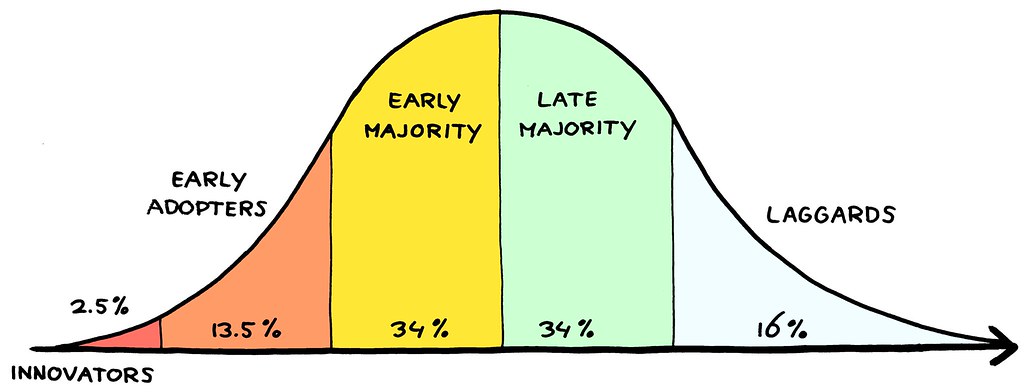I love the beginning of the school year! The enthusiasm about what’s to come, the lingering remnants of summer holidays, and the potential of another year makes a school zing with energy! After spending two fantastic weeks in Seattle working with teachers and admin in Marysville, I came back to NIST last week excited about the possibilities for my new role as Consultant in Residence. I’m not entirely sure what this role will look like as the year goes on, but I am so excited about the opportunity to work with the entire NIST community – teachers, coaches, administrators, parents and students!
 Also last week, our Eduro Learning, Coaching: From Theory To Practice, course started and I’ve been jumping back into the book Crossing The Chasm (thanks to Tico and some exciting conversations at #beyondlaptops last year). Looking to the future with Marysville and NIST, and back at YIS (and of course ISB now that I’m here in Bangkok again), has led me to think quite a bit about coaching strategies that work in different settings, with different types of teachers, and for the different kinds of personalities that coaches might have.
Also last week, our Eduro Learning, Coaching: From Theory To Practice, course started and I’ve been jumping back into the book Crossing The Chasm (thanks to Tico and some exciting conversations at #beyondlaptops last year). Looking to the future with Marysville and NIST, and back at YIS (and of course ISB now that I’m here in Bangkok again), has led me to think quite a bit about coaching strategies that work in different settings, with different types of teachers, and for the different kinds of personalities that coaches might have.
Coaching is a difficult job, even though it often appears easy. We may not have full time teaching schedules or tons of grading, but there are lots of different dynamics that make this job especially stressful (but that’s another blog post altogether). Not every strategy works for every teacher or school community, so as coaches, we need a coaching toolkit that you can tap into based on the circumstances you find yourself in on a day-to-day basis.
 Here are a few strategies that I have found successful in different settings. I would love to hear about the strategies in your toolkit too!
Here are a few strategies that I have found successful in different settings. I would love to hear about the strategies in your toolkit too!
1. Work with the willing
 This is always the most fun place to start (in my opinion). Finding those teachers that are keen and want to work with you makes both your job and the teachers job, fun and exciting. You both get to try something new, take some risks and enjoy being a learner with the students. I have found that when you’re new to a school, this is a great place to start. Finding the teachers that are willing to branch out and possibly fail means that you are developing a community of open-minded learners that will stay with you throughout your time at the school. Working with just one of these teachers often leads to other connections you might not have expected because of their network within the school as well.
This is always the most fun place to start (in my opinion). Finding those teachers that are keen and want to work with you makes both your job and the teachers job, fun and exciting. You both get to try something new, take some risks and enjoy being a learner with the students. I have found that when you’re new to a school, this is a great place to start. Finding the teachers that are willing to branch out and possibly fail means that you are developing a community of open-minded learners that will stay with you throughout your time at the school. Working with just one of these teachers often leads to other connections you might not have expected because of their network within the school as well.
Why try this strategy?
For me, the number one reason to start here is to build excitement and energy around your role in the school. Getting right into your coaching role at the beginning of the year helps demonstrate what you do through your actions, as well as builds enthusiasm about what is possible. Of course, the side bonus of these teachers sharing the great things they’ve done with you doesn’t hurt either!
However, the challenge with this strategy, is that it’s also the easiest (and easiest to stay forever, because it’s so fun). These are teachers that are already innovators, they would most like try out new ideas with or without you. Therefore other teachers may not look upon your successes with this group as something valuable for them – they are already the innovators. Plus, usually this is a small percentage of the staff. We could work with the willing teachers all year and only tap into that small group and their students, and that’s not enough. If our job is to work with all teachers, we can’t stop here.
2. Find the challenge
 For those teachers that may not quite see the value of a coach, a great place to start can be something they are struggling with – a lesson, an assessment, a unit idea, or even something techie from their personal life. As coaches, one of the things we are great at is solving problems. We love to tackle the tech that’s not working, or figure out the best tool for the task, or develop a unit that best meets the learning needs of the students while embracing new ways for students to demonstrate their learning. This is a great opportunity for working with teachers who may not immediately see a need for a coaches support. Instead of trying to add/improve/enhance the technology in units that are working well, start with units or lessons that aren’t working and see if there is an opportunity for you to help solve that problem.
For those teachers that may not quite see the value of a coach, a great place to start can be something they are struggling with – a lesson, an assessment, a unit idea, or even something techie from their personal life. As coaches, one of the things we are great at is solving problems. We love to tackle the tech that’s not working, or figure out the best tool for the task, or develop a unit that best meets the learning needs of the students while embracing new ways for students to demonstrate their learning. This is a great opportunity for working with teachers who may not immediately see a need for a coaches support. Instead of trying to add/improve/enhance the technology in units that are working well, start with units or lessons that aren’t working and see if there is an opportunity for you to help solve that problem.
Why try this strategy?
I love this strategy, because usually there is no way to go but up! If something isn’t working and you can develop a solution, not only have you improved student learning, and helped overcome a challenge for the teacher, but you’ve also demonstrated your value from a pedagogical perspective, and most likely made a coaching convert who will share their success with other teachers. There is nothing better than taking something that was a struggle for a teacher and making it a great learning experience. Often times coaching is viewed as an add on, and tech as extra work for teachers, you can take away both of those barriers by employing this strategy.
3. Move to the middle
 You can only take the “work with the willing” strategy so far. After a time, other teachers may start to see those innovators as mini-coaches, and assume that they are so far ahead that it will be impossible to catch up. Without leaving those innovators behind (more strategies on that below), it might be worth connecting with some of the teachers who may not be vocal about taking risks in their classrooms, but who are solid practitioners and would be open to at least a conversation about how you can specifically support the learning in their classroom.
You can only take the “work with the willing” strategy so far. After a time, other teachers may start to see those innovators as mini-coaches, and assume that they are so far ahead that it will be impossible to catch up. Without leaving those innovators behind (more strategies on that below), it might be worth connecting with some of the teachers who may not be vocal about taking risks in their classrooms, but who are solid practitioners and would be open to at least a conversation about how you can specifically support the learning in their classroom.
For these teachers, it’s often best to attend their curriculum planning meetings to get a better understanding of the goals for their classroom. This way your conversations start with the pedagogy and the content, and then as appropriate can involve the technology. Generally speaking, starting with something small and achievable will most likely work best with these teachers so that they can have a successful experience to build from.
Why try this strategy?
Often these are the teachers that are highly respected because they work hard, and don’t “jump on every bandwagon”, therefore the work they do is purposeful and based in sound pedagogy. When focusing on curriculum and pedagogy with these strong teachers, you can demonstrate both your understanding of teaching and learning and your value as an innovator in the classroom. Because these teachers are not the early adopters, the other middle majority teachers or even the late adopters, might find their input more valuable than the innovators.
4. Start small
 Especially when coaching is new to a school culture, sometimes it makes sense to start small by collections of resources that support student learning, basically taking the time to find the resources that teachers need, but don’t have the time to look for. I like to think of this kind of strategy as the lower end of Bloom’s taxonomy in terms of what coaches can do – you’re helping teachers “remember” resources that they might find useful, but not yet working towards analyzing, evaluating and creating learning experiences for students.
Especially when coaching is new to a school culture, sometimes it makes sense to start small by collections of resources that support student learning, basically taking the time to find the resources that teachers need, but don’t have the time to look for. I like to think of this kind of strategy as the lower end of Bloom’s taxonomy in terms of what coaches can do – you’re helping teachers “remember” resources that they might find useful, but not yet working towards analyzing, evaluating and creating learning experiences for students.
Why try this strategy?
This is a great way to demonstrate that coaching can help remove barriers (in this case the barrier of the time to research and the skills of finding developmentally appropriate material). However, the challenge with this strategy is that it does take time, and often, this time is better spent working in the classroom with teachers and students, or collaboratively planning and reflecting on learning experiences.
5. Celebrate success
 For me, this is the most important part of the coaching role – to be the cheerleader for all of the fantastic work that is happening in your school community. There are tons of different ways to highlight these great learning experiences – from speedgeeking, to hosting a blog that features work from all different classrooms, to a virtual high five – different types of sharing work best in different types of communities. It doesn’t always have to be something you have supported either, it can something you heard about from another teacher, or something you saw in action in a classroom as you were visiting.
For me, this is the most important part of the coaching role – to be the cheerleader for all of the fantastic work that is happening in your school community. There are tons of different ways to highlight these great learning experiences – from speedgeeking, to hosting a blog that features work from all different classrooms, to a virtual high five – different types of sharing work best in different types of communities. It doesn’t always have to be something you have supported either, it can something you heard about from another teacher, or something you saw in action in a classroom as you were visiting.
Why try this strategy?
Everyone appreciates being appreciated! Finding ways to applaud the great work that teachers is doing focuses on the positive and gets people sharing and talking about the learning that’s happening in classrooms around them. Also, often our days are so busy, we don’t have a chance to learn from others (or sometimes even find out what other teachers are doing), and this provides a format and a structure for sharing. Ideally, teachers will walk away thinking that they have other teachers they can connect with about new and inspiring ideas. Hopefully, they’ll also be thinking about what they might be able to share next time!
And one bonus tip!
6. Make connections
 As you start to recognize which teachers are keen to continue to learn, and ready to devote some time to this learning, finding ways to bring them together to offer more advanced learning can help build a network of like minded teachers within your community. This often starts with asking these teachers to share their successes in a celebration-style meeting, and can continue into specifically scheduled meetings for them to share with each other, or ensuring that these teachers are aware of (and personally invited to) PD opportunities in your city. Building relationships between teachers who are innovative, but might not know each other due to the size or the school, is a great way to help those innovators keep learning, even if you are spending more time with other things.
As you start to recognize which teachers are keen to continue to learn, and ready to devote some time to this learning, finding ways to bring them together to offer more advanced learning can help build a network of like minded teachers within your community. This often starts with asking these teachers to share their successes in a celebration-style meeting, and can continue into specifically scheduled meetings for them to share with each other, or ensuring that these teachers are aware of (and personally invited to) PD opportunities in your city. Building relationships between teachers who are innovative, but might not know each other due to the size or the school, is a great way to help those innovators keep learning, even if you are spending more time with other things.
Why try this strategy?
These are the people that will keep learning with or without you. Bringing them together builds a support network so that they can learn from each other, rather than in isolation. This group also provides great learning for you, as the coach, you can get an idea of what teachers want to do next, and get their feedback on ideas you might be ready to share with the whole faculty. As long as this group is kept open to others who become interested, it can also be a great model for collaborative learning (or professional learning communities).
Your Tips?
What do you think? Do these tips resonate with you? Do you have more to add? What’s in your coaching toolkit?
Images:
- Tool Belt by George Martin, CC licensed on Flickr
- Innovation Adaption Curve, by Jurgen Appelo, CC licensed on Flickr
- Racing Stripes, by JD Hancock, CC licensed on Flickr
- Climbing Mount Feathertop, by Kathryn McCallum, CC licensed on Flickr
- Steps, by Hernán Piñera, CC licensed on Flickr
- Starting Line, by Demietrich Baker, CC licensed on Flickr
- Cheerleader, by Elizabeth Albert, CC licensed on Flickr
- Connected, by Heather, CC licensed on Flickr






Kim I think that your tips are spot on. This is what I have found. Because I am still timetabled into the schedule, I find that there are times that I can demonstrate ways of doing lessons that open teachers eyes to new possibilities without them realizing what I am doing. They might at first be scared of the suggestion that I have had for a lesson, but then once they see it happen they see other ways to use it.
I don’t always see them trying things right away but they usually begin taking more risks with things, or at least asking me “Do you think … will work if I do it this way.” which is great. It show that they are beginning to transfer the knowledge and develop their own ways of using the tech that they have.
Hi Kim,
Thanks for the great tips! I have found myself in a library/tech coach position this year. The “tech coach” part of it is being built completely from scratch. It’s exciting, but hard to find focus at times :)
This post is so helpful for someone like myself, who is jumping in to a new position, in a new school, with no official job description. Your point about celebrating success especially resonated with me.